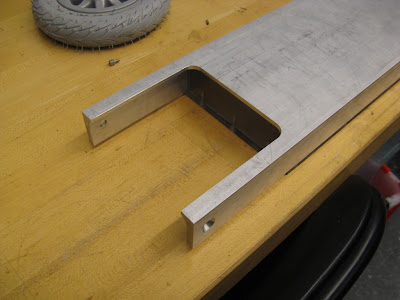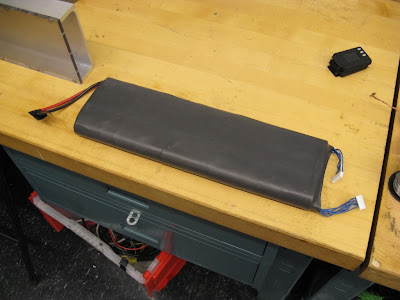1. Stator and rotor. Δt1
2. Deck fabrication. Δt2
3. Batteries. Δt2
4. Wind motor.
5. Motor-to-wheel adapter fabrication.
6. Optical encoder.
Time step #2 takes out two whole tasks: deck fabrication and batteries. They kinda go together, since the deck is primarily a box for the batteries (and secondarily something to stand on). I've learned my lesson about sheet metal decks, and I don't have the patience or waterjet access required to design complex interlocking tab/slot decks. I wanted to make billet scooter - a deck machined out of a solid block of aluminum - but my fabrication skills and personal discretionary funding are not up for that. So, I settled for the next best thing, which is a deck machined from a single aluminum u-channel.
It started as McMaster PN 1630T351. Cutting it to length was easy, but taking an inch or so off the legs was not trivial. My first thought was to clamp it base down in the mill and face the legs down to size, but this would have taken several very noisy passes. The final "solution" was to stuff three 2x4s in the space between the legs (which is conveniently 4.48"), clamp the whole stack sideways, and slice through the legs with a 1/2" end mill. This left a fairly rough surface, so I went back to Plan A for a finishing pass. The wheel well was a quick bandsaw + finishing job.
Then came the part I was dreading. 14 instances of blind-tapped 4-40 holes into the legs, plus six more into "firewalls" in front and back. It took the better part of a Sunday afternoon. I became progressively more careful because breaking a tap off in hole #20 of 20 is not a good thing. I actually did break a bottoming tap, but luckily it was in one of the firewalls which is an easily replaced piece of polycarbonate.
Should have used t-nuts...
The good thing about tapped holes like this (as opposed to t-nuts) is that it gives me a fighting chance to make the deck splash-resistant, something that would help if this is to be a true commuter vehicle.
I really like the construction of this deck. It's a good deal sturdier than BWD's sheet metal construction. The polycarbonate bottom is "abrasion resistant" (we'll see how long that lasts...) and allows the battery to be bottom-loaded instead of squeezed through an impossibly small hole in the front like BWD. Speaking of the battery:
Mystery battery is mysterious.
Actually, it's the same battery as BWD: a 20-cell A123 26650 pack in 10S2P configuration. (It's exactly like two 36V DeWalt drill packs in parallel.) In fact, for all you know that's what it is... The total pack is 33V and 4.4Ah. Unlike BWD's pack, this one is soldered instead of welded and great care was taken in laying out balance and power leads since I thought the deck space was going to be tight, especially width and height dimensions...
...Turns out I did so well that it slipped right in from the front anyway, with room to spare. The power leads come off the back to where the controller will be. I chose to put the balance leads up front for access through some kind of yet-to-be-designed flap in the front firewall. Turns out Digi-Key sells JST-XH connectors, the standard for small battery balance leads, in many sizes for pennies each. To them, I can attach the closest thing I will ever have to a battery management system:
LiFePO4...so consistent.
That's it for now. Next will probably be motor winding...







No comments:
Post a Comment